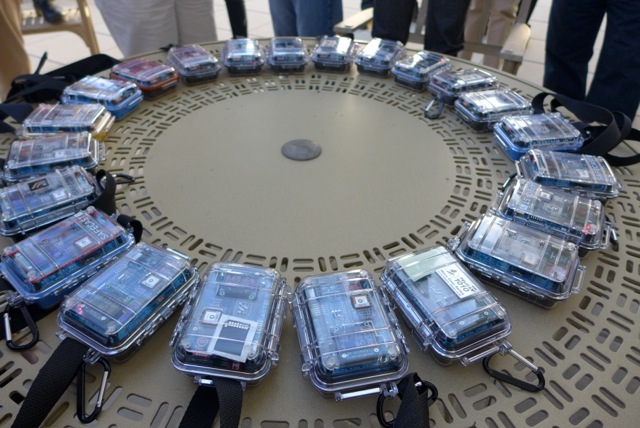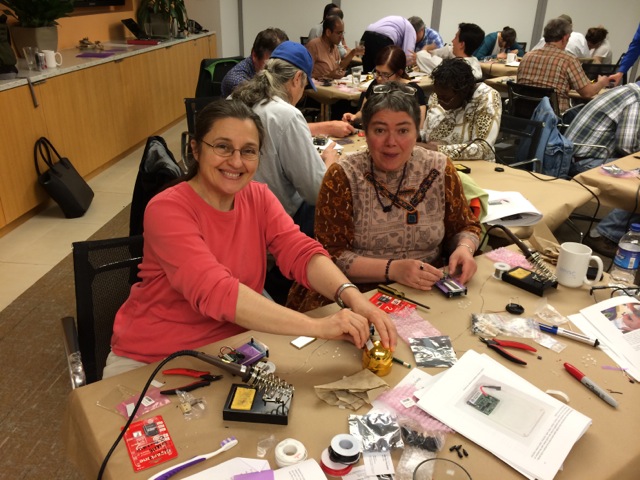
A few weeks ago I found myself in Washington DC.
I was engaged in activities I think the activist Founders of the USA would deem profoundly American – though the issues are ones they probably could not imagine in their day. The event involved democracy, freedom of information, new technologies, and, yes, Geiger Counters.
Since Fukushima Daiichi events, many Americans have been disturbed by the lack of data provided by governments on any radiation impacts. There have been a lot of problems with the EPA Radnet monitoring system, and people find it confusing. See Forbes Magazine article on Radnet. No U.S. agency is charged with monitoring radiological safety of the oceans, or the food that comes from it. Assurances that everything is okay would be better received if there were data to back it up.

Security around nuclear materials is also a big concern these days.
Many of the individuals involved in the DC event are trusted representatives of well known (and respected), independent, non profit organizations. There were also representatives from Academia. And there were US Government Agencies charged with protecting public health, safety and security.

The common interests of these groups revolve around things nuclear: preventing bad things from happening, and dealing with the problems if/when bad things do happen. A complete list of organizations represented is contained in this blog post by Bemnet Alamayehu at Natural Resources Defense Council (NRDC) . NRDC sponsored the event with support from the John D. and Katherine T. MacArthur Foundation.
The eventʻs outstanding success was due largely to the good reputation NRDC has achieved over many years by working in the public interest on complex environmental and security issues. The NY Times calls NRDC “One of the nation’s most powerful environmental groups.” NRDC has for decades supported the important role of independent citizens in radiation monitoring programs. In the nuclear arena there is also tremendous goodwill and respect afforded NRDC for their innovation and success in supporting international nuclear safety and arms control programs. I have personally been a fan, volunteer and a supporter of NRDC for decades. Earlier work with NRDC took me to Post-Chernobyl Russia and Belarus to support communities in an independent radiation monitoring program – at a time the old USSR (under which it was illegal for citizens to possess a geiger counter) was crumbling .
The form this particular exercise in democracy took, and how it unfolded on this day, would not have been possible without the participation of the good people from Safecast, who designed the system and the instruments we used, facilitated the detector building workshop, and co-facilitated the deployment and mapping exercise, with NRDC. Safecast developed a technologically advanced system for rapidly compiling radiation data in response to the March 2011 events at Fukushima Daiichi, Japan. Safecast covered the Washington DC event at this blog post on their website. I have also been a supporter, volunteer, technology provider and advisor to Safecast since April 2011.

To get to the point, we basically hand built a lot of the Safecast “Nano” radiation detectors. They are uniquely equipped with satellite GPS receivers, specialized sensors, and micro SD card data loggers. We fanned out around the centers of power and historic sites in the nationʻs capitol, logged radiation levels, and then published the data to the world wide web – all within 32 hours. The data can now be viewed on the Safecast iPhone App (available free at the Apple Store) We also installed a real-time radiation monitoring station at NRDC Washington D.C. Headquarters, just a few blocks from the White House.

Could our activities in any way compromise National Security? I have asked myself that question many times over the years – when I have been asked to become involved in community monitoring projects. I could not imagine any problems, and have never seen anything but positive impact on communities. Apparently the Department of Homeland Security and National Nuclear Security Agency agreed. They sent representatives to observe and participate.
Freedom of Information is a basic tenant of Democracy, and also recognized internationally as a basic human right. Informed citizenry is considered to be a foundation of strong democracies. Security is something all communities naturally strive for. The overwhelming majority of us want our cities, our children, to be safe.
The more radiation detectors and data out there the safer we are, I believe. If anything unusual surfaces, we all want to know about it – and to feel empowered to take appropriate action. The good news is that radiation levels around the White House, the US Congress, the Washington Mall all look pretty normal (see color coded map above). The slightly elevated readings around the World War II Memorial are due to naturally occurring material in the granite monuments.
More events are in the planning stage. Your city may be next. Stay tuned.

Comments closed

